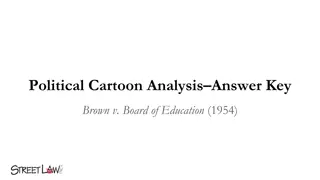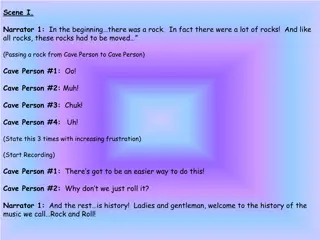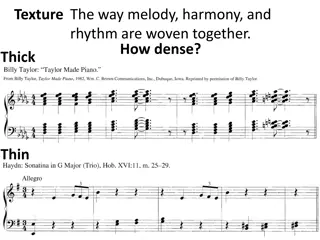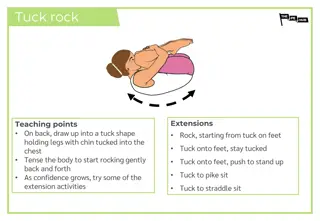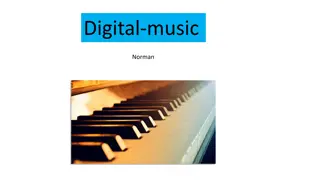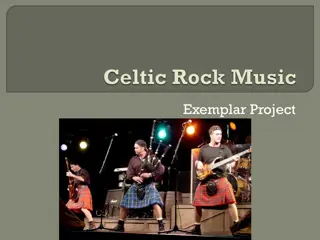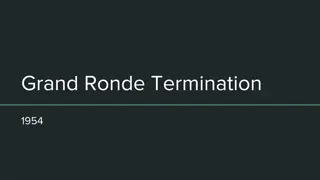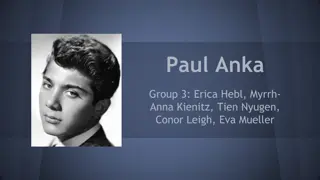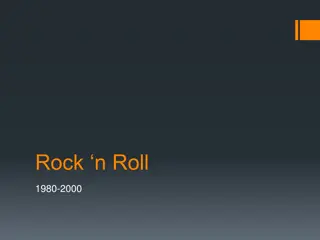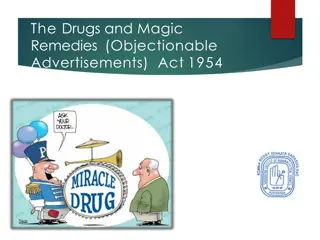Evolution of Rock Melody: 1954-2009 Analysis
Analyzing changes in rock melody from 1954 to 2009, this study incorporates data from the Rolling Stone corpus, including top songs from different decades. The corpus, initially based on Rolling Stone's list of the 500 Greatest Songs of All Time (2004), has been updated with songs from the 2000s. Melodic and harmonic analyses were conducted on 239 songs, with detailed transcriptions provided for melodies and harmony. The corpus spans unevenly across decades, with a focus on popular songs and their musical structures.
Download Presentation

Please find below an Image/Link to download the presentation.
The content on the website is provided AS IS for your information and personal use only. It may not be sold, licensed, or shared on other websites without obtaining consent from the author.If you encounter any issues during the download, it is possible that the publisher has removed the file from their server.
You are allowed to download the files provided on this website for personal or commercial use, subject to the condition that they are used lawfully. All files are the property of their respective owners.
The content on the website is provided AS IS for your information and personal use only. It may not be sold, licensed, or shared on other websites without obtaining consent from the author.
E N D
Presentation Transcript
Changes in Rock Melody, 1954- 2009 David Temperley1, Adam Waller1, and Trevor de Clercq2 (1) Eastman School of Music, University of Rochester (2) Middle Tennessee State University 1
The Rolling Stone corpus A long-term project to gather statistical data about melody and harmony in rock. 2
The initial corpus was based on Rolling Stonemagazines list of the 500 Greatest Songs of All Time (2004). The top 10 songs from the list: 1 Bob Dylan, Like a Rolling Stone (1965) 2 The Rolling Stones, Satisfaction (1965) 3 John Lennon, Imagine (1971) 4 Marvin Gaye, What's Going On (1971) 5 Aretha Franklin, Respect (1967) 6 The Beach Boys, Good Vibrations (1966) 7 Chuck Berry, Johnny B. Goode (1958) 8 The Beatles, Hey Jude (1968) 9 Nirvana, Smells Like Teen Spirit (1991) 10 Ray Charles, What'd I Say (1959) We analyzed 200 songs from this list. The corpus spans roughly 1954 to 2000, with a couple of outliers (one song from 1949, one from 2004). For simplicity, we ll refer to it as the 1950-2000 set. 3
To make the corpus more current, we have recently added some songs from Rolling Stone slist of the 100 best songs of the 2000s (2000-2009). The top 10: 1 2 3 4 5 6 7 8 9 10 Eminem, Stan Gnarls Barkley, Crazy Jay-Z, 99 Problems Beyonce, Crazy In Love OutKast, Hey Ya! M.I.A., Paper Planes The White Stripes, Seven Nation Army Yeah Yeah Yeahs, Maps Amy Winehouse, Rehab U2, Beautiful Day We took the top 40 songs from the list. One of these, Eminem s Lose Yourself (2002), was already in the earlier set, so in effect we added 39 new songs. (Both Rolling Stone lists were based on polls in which performing artists and other music industry insiders were asked to name the best or greatest songs of the era.) 4
Number of Songs 36 86 38 19 20 40 Decade 1950s 1960s 1970s 1980s 1990s 2000s The balance of the corpus across the decades is rather uneven, due to the uneven composition of the original Top 500 list. 5
We analyzed the harmony of all the songs, in Roman numeral notation. The analysis of the Beatles Hey Jude : [F] I | V | | I | IV | I | V | I | (etc.) We also transcribed the melodies of all the songs, in scale-degree notation. The first verse of Hey Jude : [F] [OCT=4] ...5 | 3....356 | v2.....23 | 4.^1..175 | 6.543.........5. | 6.6...6.21.7.16. | 5...v1236 | 5..543.7 | 1.....^5. (etc.) Out of the 239 songs total, 15 had little or no melody (e.g. rap songs), so no melodic transcriptions were done. And 10 songs were judged to have no significant harmonic content. This left 224 songs with melodic data, and 229 with harmonic data. Analyses and transcriptions of the original 200-song set are available at www.theory.esm.rochester.edu/rock_corpus Data for the more recent songs will be made available soon. 6
In previous work, we have explored several aspects of the data (using just the 1950-2000 set): - Distribution of roots and root transitions (de Clercq & Temperley, 2011) - Scale-degree distributions (in both melodic and harmonic data) (Temperley & de Clercq, 2013) - Key identification (Temperley & de Clercq, 2013) - Cadences (Temperley, 2011) - The relationship between harmony and form (de Clercq, 2014) 7
In this paper we focus especially on issues of historical change in the corpus from 1950-2009, focusing on the melodic data. 8
While the current study is mainly exploratory not guided by specific hypotheses we were especially interested in changes in scale-degree distribution. Scale-degree distributions can easily be gathered from the melodic transcriptions, since notes are directly represented in that way: 1, b2, 2, b3, 3, etc. All notes are weighted equally (not by duration). In earlier work (reported in Temperley & de Clercq, 2013), we took the scale-degree distributions from the 1950-2000 songs and clustered them, using a variant of the K-means method. (We did this partly to investigate the validity of the major / minor distinction in rock, which is controversial.) 9
Scale-degree Distributions in Rock Songs, 1950-2000 (Clustering Analysis) 0.35 0.3 0.25 0.2 C1 (107 songs) C2 (87 songs) 0.15 0.1 0.05 0 1 b2 2 b3 3 4 #4 5 b6 6 b7 7 A 2-cluster solution provided a good fit to the data. This shows the mean distributions of the two clusters. 10
Scale-degree Distributions in Rock Songs, 1950-2000 (Clustering Analysis) 0.35 0.3 0.25 0.2 C1 (107 songs) C2 (87 songs) 0.15 0.1 0.05 0 1 b2 2 b3 3 4 #4 5 b6 6 b7 7 The red cluster corresponds very closely to the major scale. 11
Scale-degree Distributions in Rock Songs, 1950-2000 (Clustering Analysis) 0.35 0.3 0.25 0.2 C1 (107 songs) C2 (87 songs) 0.15 0.1 0.05 0 1 b2 2 b3 3 4 #4 5 b6 6 b7 7 The blue cluster is perhaps a kind of minor ; b3 is more frequent than 3. But b7 > 7 and 6 > b6; this is quite unlike classical ( harmonic ) minor. 12
Scale-degree Distributions in Rock Songs, 1950-2000 (Clustering Analysis) 0.35 0.3 0.25 0.2 C1 (107 songs) C2 (87 songs) 0.15 0.1 0.05 0 1 b2 2 b3 3 4 #4 5 b6 6 b7 7 One could posit an 8-note scale, 1-2-b3-3-4-5-6-b7; this could be seen as a combination of the major and minor pentatonic scales (we call it the pentatonic union scale). 13
The pentatonic union scale is also reflected in numerous individual songs. Temperley & de Clercq (2013) speculated that this might reflect the influence of the blues. major pent. 1 2 b3 3 4 5 6 b7 minor pent. Blues-based melodies are often pentatonic, and also often contain mixtures of major and minor pentatonic e.g. combining 3 and b3, or using both b3 (from the minor) and 6 (from the major), as in the Rolling Stones (I Can t Get No) Satisfaction. 14
It seems clear that the influence of the blues on popular music has declined in recent decades reflected in the declining use of blues-based harmonic progressions, for example. So if the pentatonic union scale does reflect blues influence, we might expect it to become less prevalent though it s not clear what would take its place. Adding in the new (2000s) songs, we examined the change in melodic scale-degree distributions over the decades. 15
We first split the data into two chronological periods, 1950-1979 and 1980-2009. The overall scale-degree distributions for the two periods: 0.3 0.25 0.2 1950-79 (157 songs) 1980-2009 (66 songs) 0.15 0.1 0.05 0 1 b2 2 b3 3 4 #4 5 b6 6 b7 7 The two periods seem similar overall though there are some subtle differences that may be important (as we ll see...) 16
We then split each chronological set into major and minor songs, by a very simple criterion: a song is major if 3 occurs more often than b3, minor otherwise. This achieves very similar results to the K-means clustering method used before. On the 1950-2000 set, 175 out of the 194 melodies (90%) are categorized in the same way by these two methods. (One song from the 2000s set, Radiohead s Everything in its Right Place, uses neither 3 or b3, so it is not included in either category.) 17
We then looked at the scale-degree distributions for the major and minor groups in both historical periods. For the major songs: 0.3 0.25 0.2 1950-79 (99 songs) 1980-2009 (41 songs) 0.15 0.1 0.05 0 1 b2 2 b3 3 4 #4 5 b6 6 b7 7 The distributions for the two periods are strikingly similar (yes, there are two lines here!). 18
For the minor set, the two periods also show quite similar distributions, but there is one very noticeable difference... 0.35 0.3 0.25 0.2 1950-79 (58 songs) 1980-2009 (25 songs) 0.15 0.1 0.05 0 1 b2 2 b3 3 4 #4 5 b6 6 b7 7 19
For the minor set, the two periods also show quite similar distributions, but there is one very noticeable difference.. 0.35 0.3 0.25 0.2 1950-79 (58 songs) 1980-2009 (25 songs) 0.15 0.1 0.05 0 1 b2 2 b3 3 4 #4 5 b6 6 b7 7 In the earlier period, 6 > b6 (reflecting the pentatonic union scale, or perhaps Dorian mode). In the later period, b6 > 6 more like Aeolian (natural minor). 20
0.35 0.3 0.25 0.2 1950-79 (58 songs) 1980-2009 (25 songs) 0.15 0.1 0.05 0 1 b2 2 b3 3 4 #4 5 b6 6 b7 7 Aeolian 21
Also, 3 is lower in the later period, and b3 is higher, so there is less mixture of b3 and 3 again, more like pure Aeolian (and again may represent declining influence of the blues). 0.35 0.3 0.25 0.2 1950-79 (58 songs) 1980-2009 (25 songs) 0.15 0.1 0.05 0 1 b2 2 b3 3 4 #4 5 b6 6 b7 7 Other small differences in the later period the increase in 5 and decrease in 1 are harder to interpret. 22
The most striking difference between the two periods is the shift in b6 and 6 in minor. But the number of songs in our corpus is fairly small: is this difference statistically significant? One way of analyzing this is to represent each minor song with a single number, the submediant ratio : submediant ratio = (count of 6) / (count of 6 + b6) ...the proportion of submediant notes that are 6 rather than b6. The data just shown suggests that this tends to decline over time. 23
Average submediant ratio in minor songs, by decade 1.2 1 0.8 0.6 0.4 0.2 0 1950s 1960s 1970s 1980s 1990s 2000s ...A pretty consistent pattern. 24
Submediant ratios in individual songs (minor songs only), shown chronologically 1 0.9 0.8 0.7 0.6 0.5 0.4 0.3 0.2 0.1 0 1950 1960 1970 1980 1990 2000 2010 (Shaded markers indicate more than one data point.) Again a consistent pattern, and highly significant (r = .74, p < .0001). 25
The relative decrease in 6 (and increase in b6) in minor seems plausibly related to declining blues influence. But what is replacing it? Natural minor? What else would we expect to see if this is the case? Perhaps a shift from pentatonic melody to more diatonic melody. 26
Diatonic and pentatonic scales have different interval distributions (within the octave): Interval m2 M2 m3 M3 P4 TT Diatonic 2 5 4 3 6 1 Pentatonic 0 3 2 1 4 0 Diatonic scales contain half-steps (m2); pentatonic scales do not. If popular music has been getting more diatonic, we would expect to see more melodic half-steps. 27
Comparing melodic interval distributions between the two historical periods (1950-79 and 1980-2009): 0.4 0.35 0.3 0.25 1950-79 1980-2009 0.2 0.15 0.1 0.05 0 -12-11-10 -9 -8 -7 -6 -5 -4 -3 -2 -1 0 1 2 3 4 5 6 7 8 9 10 11 12 Half-steps 28
Comparing melodic interval distributions between the two historical periods (1950-79 and 1980-2009): 0.4 0.35 0.3 0.25 1950-79 1980-2009 0.2 0.15 0.1 0.05 0 -12-11-10 -9 -8 -7 -6 -5 -4 -3 -2 -1 0 1 2 3 4 5 6 7 8 9 10 11 12 Whole-steps become slightly less common in the later period. But half- steps are no more common (in fact, very slightly less so). So there is little evidence of a shift to diatonicism. (This is for ALL songs, major and minor but just looking at minor songs yields similar results.) 29
Comparing melodic interval distributions between the two historical periods (1950-79 and 1980-2009): 0.4 0.35 0.3 0.25 1950-79 1980-2009 0.2 0.15 0.1 0.05 0 -12-11-10 -9 -8 -7 -6 -5 -4 -3 -2 -1 0 1 2 3 4 5 6 7 8 9 10 11 12 More striking is the increase in repeated notes. Ascending and descending 4ths (+5, -5) also become more common. Average interval size is practically unchanged (2.06 in the earlier period, 1.92 in the later period). 30
Schellenberg and van Scheve (2012) found increasing use of minor in recent popular music. In our corpus, the proportion of melodies in minor is virtually unchanged between the earlier and later periods... Proportion of melodies in minor 1.00 0.90 0.80 0.70 0.60 0.50 0.38 0.37 0.40 0.30 0.20 0.10 0.00 1950-79 1980-2009 31
Conclusions Between the first and second thirty years of rock, the overall scale- degree distributions have been quite stable. The main change has been an increase in the frequency of b6 and a decrease in 6 in minor songs. This may point to a move away from pentatonic, blues-based organization and a move towards natural minor. However, the distribution of intervals does not reflect this. 32
One might wonder whether the results are due to the particular set of songs that the corpus happens to include. One might ask, indeed, what the corpus is supposed to represent. (Those polled for the earlier list were asked to name the greatest songs of the rock and roll era ; those polled for the later list were asked to name the best songs of the 2000s.) Perhaps all one can say is that the corpus represents a fairly broad spectrum of late 20th-century / early 21st-century popular music. 33
Further questions about historical change in popular music - Do the harmonic analyses of recent songs reflect an analogous shift towards natural minor? (We have just finished the harmonic analyses of the 2000s songs and have not yet done much with them.) - Does the melodic data reflect a rise or fall in complexity over time? It has been suggested that popular music has gotten simpler (Serra et al., 2011). - Does the melodic data (in combination with the harmonic data) reflect a shift in the coordination between melody and harmony? A degree of independence between melody and harmony is characteristic of earlier rock again, perhaps, reflecting blues influence (Temperley, 2007). 34
References de Clercq, T. 2014. Typical Chords in Typical Song Sections: How Harmony and Form Interact in a Corpus of Rock Music. Eighth European Music Analysis Conference (EuroMAC). de Clercq, T., & Temperley, D. 2011. "A Corpus Analysis of Rock Harmony." Popular Music 30, 47-70. Schellenberg, G., & van Scheve, C. 2012. Emotional cues in American popular music: Five decades of the Top 40. Psychology of Aesthetics, Creativity, and the Arts, 6, 196 203. Serr , J., Corral, A., Boguna, A., Haro, M., & Arcos, J. 2012. Measuring the Evolution of Contemporary Western Popular Music. Scientific Reports 2, article 521. Temperley, D. 2007. "The Melodic-Harmonic 'Divorce' in Rock." Popular Music 26 #2, 323- 342. Temperley, D. 2011. "The Cadential IV in Rock." Music Theory Online 17.1. Temperley, D., & de Clercq, T. 2013. Statistical Analysis of Harmony and Melody in Rock Music. Journal of New Music Research 42, 187-204. 36


